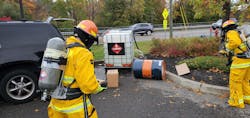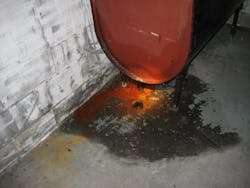If you remember back to the Ye Olde times of your probationary period, you might remember the hazardous materials-operations level training segment. In that class, instructors said a whole bunch of nerdy terms, including radiation, specific gravity and solubility. Among these, solubility stands out as a particularly important concept to grasp, given its significant implications on firefighting operations.
In the mix
Solubility is basically how well substances mix together. Think of it like you are making lemonade. The sugar dissolves in the water and then mixes smoothly into a sweet drink. In the context of hazmat, solubility determines how substances dissolve in liquids. Because we’re professional water slingers, we primarily use water as our reference point. That’s mostly because of its abundance and familiarity.
However, it isn’t just about “sugar and water.” Solubility is about understanding which chemicals mix and which don’t and how that affects firefighting strategies. Remember, water is a chemical.
Why you should care
Firefighting is a dirty operation. We go into a fire and might crawl through who knows what on the floor, all while we move through an exhaust pipe-like smoke situation that we’re finding out can be absorbed through the skin, bringing with it health issues. At an automobile accident, we walk through fuel and oil that spilled on the ground. How about when we pull out that weird device that sucks up foam and dispenses the bubbles? The decision regarding which foam that we select is affected by our understanding of solubility.
In the simplest terms, it comes down to polar or nonpolar—or, for a hazmat person, “like dissolves like.” Put another way, polar can dissolve polar and nonpolar can dissolve nonpolar. Polar and nonpolar are fancy terms to describe whether molecules are social butterflies or loners.
Polar substances, such as alcohol and salts, love water and dissolve easily. They’re the life of the party. Nonpolar substances, such as oils and some plastics, are wallflowers and prefer to keep to themselves and not dissolve in water.
In the circumstance of a spill, knowing whether the substance is the life of the party or a loner helps to determine the best cleanup strategy. For water-mixers, dilution might be a viable option. For the nonmixers, you’re looking at barriers and absorbents to address the situation.
Using the right foam
Lobbing foam isn’t something that we do all of the time. Further, from a historical perspective, we used to have a multitude of foams that were specific to the application. You have a fuel fire, use this one. You have a solvent fire, use that one.
Foam is designed to smother fire by creating a barrier between the fuel and the air. We use this approach to stop a fire that generally can’t be handled by water alone. Another property that foams have is the capability to suppress vapors, which we harness in the hazmat realm, which requires us to consider solubility in a different manner.
We may apply a layer of foam to stop a liquid that might be emitting flammable vapors into the air and creating a hazardous situation for operating firefighters. Remember, if the vapors mix with the air in a certain concentration, we have an issue. It’s for this reason that our meter must be in play at scenes to check for the presence of a hazard. If the meter shows an unacceptable reading, simply apply foam, stop the vapor production and watch the numbers go down. It’s kind of like putting the cap on the bottle. Our problem comes when the foam is soluble. Then, the foam dissolves into the liquid without ever making the vapors stop. Check out this YouTube video.
Spill-response solubility
When a chemical spill occurs, the immediate goal of responders is to contain the spill and confine it to a small area to prevent further dispersion. Solubility informs whether water can be used to dilute the substance (if the substance is water-soluble) or whether dilution via water would exacerbate the problem.
For water-soluble chemicals, using water as a diluent might be an effective way to reduce the concentration of the chemical to safer levels. This concept has a limit though. Sometimes, dilution causes a bigger problem than just dealing with the “concentrated” form of the chemical. For substances that are insoluble in water, adding water might spread the substance farther or create additional hazards. For example, let’s say that you have a gallon of a very corrosive substance and you decide to dilute it out. Your original one-gallon problem might become a 100,000-gallon problem with this method, assuming that the substance dilutes.
So, in the case of insoluble chemicals, you might need to turn to absorbents, such as speedy dry/kitty litter or absorbent wipes and towels. For example, hydrophobic (water-repelling) absorbents are preferred for oil-based substances that don’t mix with water. You commonly find these absorbents at marine stores.
A practical tool
For firefighters, solubility isn’t just a chapter in a chemistry book. It’s a critical piece of knowledge that informs strategies, ensures safety and protects the environment. By understanding the basics of solubility, you’re better equipped to tackle the challenges that are posed by chemical fires and spills and to make informed decisions that can save lives and minimize environmental damage.
Let’s embrace the science of solubility, not as a daunting academic subject, but as a practical tool in our firefighting arsenal.








